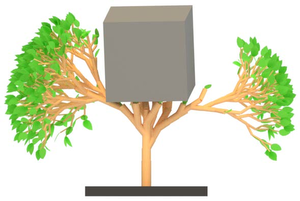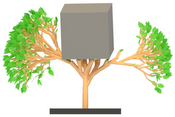Information
- Publication Type: Bachelor Thesis
- Workgroup(s)/Project(s):
- Date: August 2017
- Date (Start): 4. March 2016
- Date (End): 9. August 2017
- Matrikelnummer: 1327344
- First Supervisor: Michael Wimmer
- Keywords: l-systems, algorithmic botany
Abstract
Lindenmayer systems, or L-systems, are a well-established and thoroughly studied concept in the field of computer graphics. Originally introduced by theoretical botanist Aristid Lindenmayer to model the development of simple multicellular organisms, they are now commonly associated with the modeling of whole plants and complex branching structures. Various extensions such as stochastic, parametric and context-sensitive L-systems have been introduced to the formalism, allowing the modeling of stochastic, continuous growth and complex interactions of plant organisms with each other and with the external environment. More specialized interactive techniques are arguably better suited to more intuitively and predictably produce plant structures where artistic control is essential. Nonetheless, L-systems remain a fascinating and powerful methodology as they allow for the description of patterns of astonishing diversity via simple formal rules of production and graphical interpretation of the results. Small changes to these rules often yield unexpected but aesthetically fascinating results and the plethora of forms and patterns thus produced constitute a subject of study that is highly worthwhile in itself.The focus of this work is not to present novel techniques for the aesthetic or biological modeling of plants. This work aims at integrating the existing formalism of parametric, context-sensitive L-systems in a widely used open-source computer graphics software like Blender in the form of an add-on, as well as to discuss the potential advantages of such an integration. In this regard, special consideration is given to allow the modeling of environmental interaction of a growing structure with a Blender scene.
Additional Files and Images
Weblinks
BibTeX
@bachelorsthesis{LEOPOLD-2017-ALG,
title = "Algorithmic Botany via Lindenmayer Systems in Blender",
author = "Nikole Leopold",
year = "2017",
abstract = "Lindenmayer systems, or L-systems, are a well-established
and thoroughly studied concept in the field of computer
graphics. Originally introduced by theoretical botanist
Aristid Lindenmayer to model the development of simple
multicellular organisms, they are now commonly associated
with the modeling of whole plants and complex branching
structures. Various extensions such as stochastic,
parametric and context-sensitive L-systems have been
introduced to the formalism, allowing the modeling of
stochastic, continuous growth and complex interactions of
plant organisms with each other and with the external
environment. More specialized interactive techniques are
arguably better suited to more intuitively and predictably
produce plant structures where artistic control is
essential. Nonetheless, L-systems remain a fascinating and
powerful methodology as they allow for the description of
patterns of astonishing diversity via simple formal rules of
production and graphical interpretation of the results.
Small changes to these rules often yield unexpected but
aesthetically fascinating results and the plethora of forms
and patterns thus produced constitute a subject of study
that is highly worthwhile in itself. The focus of this work
is not to present novel techniques for the aesthetic or
biological modeling of plants. This work aims at integrating
the existing formalism of parametric, context-sensitive
L-systems in a widely used open-source computer graphics
software like Blender in the form of an add-on, as well as
to discuss the potential advantages of such an integration.
In this regard, special consideration is given to allow the
modeling of environmental interaction of a growing structure
with a Blender scene.",
month = aug,
address = "Favoritenstrasse 9-11/E193-02, A-1040 Vienna, Austria",
school = "Institute of Computer Graphics and Algorithms, Vienna
University of Technology ",
keywords = "l-systems, algorithmic botany",
URL = "https://www.cg.tuwien.ac.at/research/publications/2017/LEOPOLD-2017-ALG/",
}

 thesis
thesis

